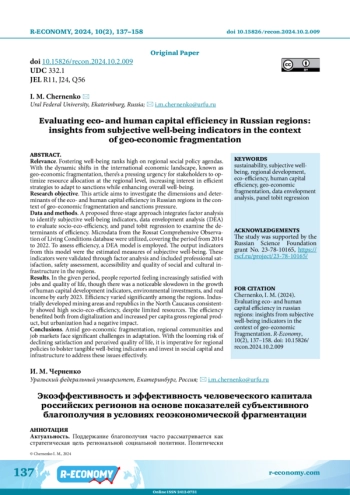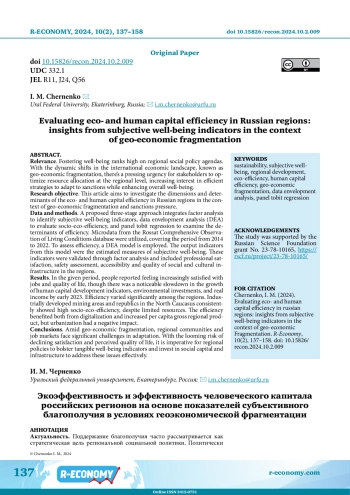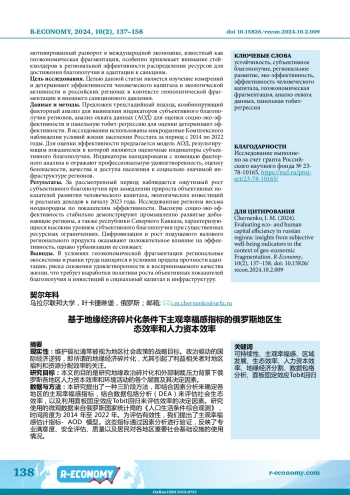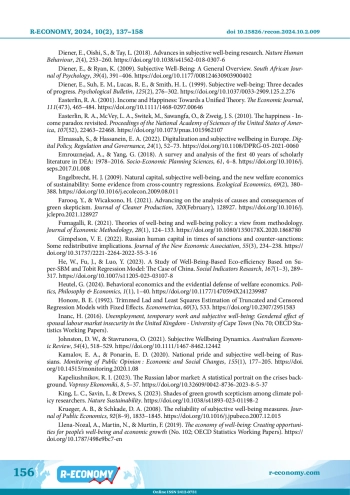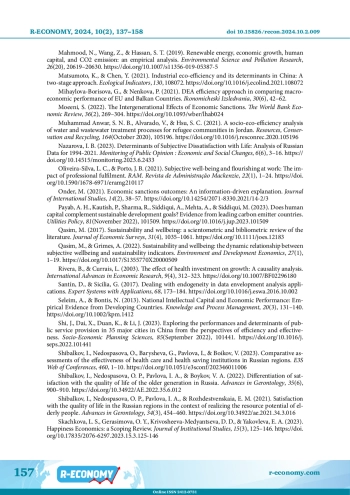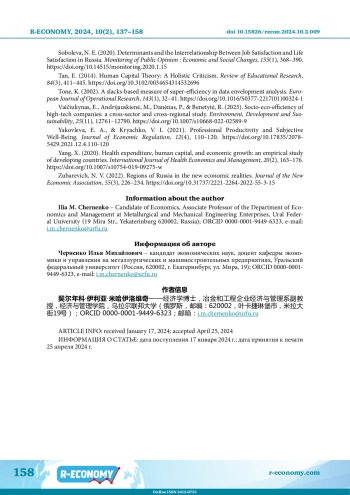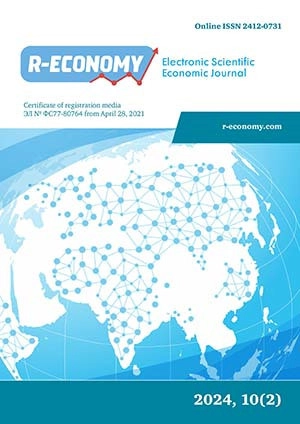Relevance. Fostering well-being ranks high on regional social policy agendas. With the dynamic shifts in the international economic landscape, known as geo-economic fragmentation, there’s a pressing urgency for stakeholders to optimize resource allocation at the regional level, increasing interest in efficient strategies to adapt to sanctions while enhancing overall well-being. Research objective. This article aims to investigate the dimensions and determinants of the eco- and human capital efficiency in Russian regions in the context of geo-economic fragmentation and sanctions pressure. Data and methods. A proposed three-stage approach integrates factor analysis to identify subjective well-being indicators, data envelopment analysis (DEA) to evaluate socio-eco-efficiency, and panel tobit regression to examine the determinants of efficiency. Microdata from the Rossat Comprehensive Observation of Living Conditions database were utilized, covering the period from 2014 to 2022. To assess efficiency, a DEA model is employed. The output indicators from this model were the estimated measures of subjective well-being. These indicators were validated through factor analysis and included professional satisfaction, safety assessment, accessibility and quality of social and cultural infrastructure in the regions. Results. In the given period, people reported feeling increasingly satisfied with jobs and quality of life, though there was a noticeable slowdown in the growth of human capital development indicators, environmental investments, and real income by early 2023. Efficiency varied significantly among the regions. Industrially developed mining areas and republics in the North Caucasus consistently showed high socio-eco-efficiency, despite limited resources. The efficiency benefited both from digitalization and increased per capita gross regional product, but urbanization had a negative impact. Conclusions. Amid geo-economic fragmentation, regional communities and job markets face significant challenges in adaptation. With the looming risk of declining satisfaction and perceived quality of life, it is imperative for regional policies to bolster tangible well-being indicators and invest in social capital and infrastructure to address these issues effectively.
Идентификаторы и классификаторы
Sustainable practices have encountered significant challenges in recent years, primarily due to limited resources and growing skepticism towards environmental initiatives among consumers, businesses (Farooq & Wicaksono, 2021), and academia (King et al., 2023). This trend is exacerbated by deglobalization and geopolitical fragmentation, hindering global commitments to sustainability and economic growth (Aiyar et al., 2023). Geo-economic fragmentation, driven by political motives, divides global economic activity into blocs or regions, disrupting supply chains, reproductive and knowledge systems, and amplifying social vulnerability, especially in nations facing sanctions (Campos et al., 2023).
Список литературы
1. Aiyar S. et al. (2023). Geo-Economic Fragmentation and the Future of Multilateralism. IMF Working Papers, SDN/2023/0(1), 38. DOI: 10.5089/9798400229046.006
2. Almakaeva A. M., Gashenina N. V. (2020). Subjective Well-Being: Conceptualization, Assessment and Russian Specifics. Monitoring of Public Opinion: Economic and Social Changes, 155(1), 4-13. DOI: 10.14515/monitoring.2020.1.01 EDN: DMOKVS
3. Austin A. (2016). On Well-Being and Public Policy: Are We Capable of Questioning the Hegemony of Happiness? Social Indicators Research, 127(1), 123-138. DOI: 10.1007/s11205-015-0955-0 EDN: VJDOQC
4. Bérenger V., Verdier-Chouchane A. (2007). Multidimensional Measures of Well-Being: Standard of Living and Quality of Life Across Countries. World Development, 35(7), 1259-1276. DOI: 10.1016/j.worlddev.2006.10.011
5. Campos R. G., Estefania-Flores J., Furceri D., Timini J. (2023). Geopolitical fragmentation and trade. Journal of Comparative Economics, 51(4), 1289-1315. DOI: 10.1016/j.jce.2023.06.008 EDN: AZJIXN
6. Castellano R., De Bernardo G., Punzo G. (2023). Well-being in OECD countries: an assessment of technical and social efficiency using data envelopment analysis. International Review of Economics, 70(2), 141-176. DOI: 10.1007/s12232-023-00413-y EDN: JYJXRS
7. Cepni O., Demirer R., Pham L., Rognone L. (2023). Climate uncertainty and information transmissions across the conventional and ESG assets. Journal of International Financial Markets, Institutions and Money, 83(December 2022), 101730. DOI: 10.1016/j.intfin.2022.101730 EDN: SRGXWG
8. Diener E., Oishi S., Tay L. (2018). Advances in subjective well-being research. Nature Human Behaviour, 2(4), 253-260. DOI: 10.1038/s41562-018-0307-6 EDN: VFWKBB
9. Diener E., Ryan K. (2009). Subjective Well-Being: A General Overview. South African Journal of Psychology, 39(4), 391-406. DOI: 10.1177/008124630903900402
10. Diener E., Suh E. M., Lucas R. E., Smith H. L. (1999). Subjective well-being: Three decades of progress. Psychological Bulletin, 125(2), 276-302. DOI: 10.1037/0033-2909.125.2.276 EDN: GZSKZP
11. Easterlin R. A. (2001). Income and Happiness: Towards a Unified Theory. The Economic Journal, 111(473), 465-484. DOI: 10.1111/1468-0297.00646 EDN: DYFTFV
12. Easterlin R. A., McVey L. A., Switek M., Sawangfa O., Zweig J. S. (2010). The happiness - Income paradox revisited. Proceedings of the National Academy of Sciences of the United States of America, 107(52), 22463-22468. DOI: 10.1073/pnas.1015962107 EDN: XZWFKP
13. Elmassah S., Hassanein E. A. (2022). Digitalization and subjective wellbeing in Europe. Digital Policy, Regulation and Governance, 24(1), 52-73. DOI: 10.1108/DPRG-05-2021-0060 EDN: RDMSZA
14. Emrouznejad A., Yang G. (2018). A survey and analysis of the first 40 years of scholarly literature in DEA: 1978-2016. Socio-Economic Planning Sciences, 61, 4-8. DOI: 10.1016/j.seps.2017.01.008
15. Engelbrecht H. J. (2009). Natural capital, subjective well-being, and the new welfare economics of sustainability: Some evidence from cross-country regressions. Ecological Economics, 69(2), 380-388. DOI: 10.1016/j.ecolecon.2009.08.011
16. Farooq Y., Wicaksono H. (2021). Advancing on the analysis of causes and consequences of green skepticism. Journal of Cleaner Production, 320(February), 128927. DOI: 10.1016/j.jclepro.2021.128927 EDN: AINUPJ
17. Fumagalli R. (2021). Theories of well-being and well-being policy: a view from methodology. Journal of Economic Methodology, 28(1), 124-133. DOI: 10.1080/1350178X.2020.1868780 EDN: LYKDES
18. Gimpelson V. E. (2022). Russian human capital in times of sanctions and counter-sanctions: Some redistributive implications. Journal of the New Economic Association, 55(3), 234-238. DOI: 10.31737/2221-2264-2022-55-3-16 EDN: KYTOVM
19. He W., Fu J., Luo Y. (2023). A Study of Well-Being-Based Eco-efficiency Based on Super-SBM and Tobit Regression Model: The Case of China. Social Indicators Research, 167(1-3), 289-317. DOI: 10.1007/s11205-023-03107-8 EDN: NYDTHW
20. Heutel G. (2024). Behavioral economics and the evidential defense of welfare economics. Politics, Philosophy & Economics, 1(1), 1-40. DOI: 10.1177/1470594X241239987 EDN: ZRCIXS
21. Honore B. E. (1992). Trimmed Lad and Least Squares Estimation of Truncated and Censored Regression Models with Fixed Effects. Econometrica, 60(3), 533. DOI: 10.2307/2951583 EDN: HGBIOX
22. Inanc H. (2016). Unemployment, temporary work and subjective well-being: Gendered effect of spousal labour market insecurity in the United Kingdom - University of Cape Town (No. 70; OECD Statistics Working Papers).
23. Johnston D. W., Stavrunova O. (2021). Subjective Wellbeing Dynamics. Australian Economic Review, 54(4), 518-529. DOI: 10.1111/1467-8462.12442 EDN: NRIWTQ
24. Kamalov E. A., Ponarin E. D. (2020). National pride and subjective well-being of Russians. Monitoring of Public Opinion: Economic and Social Changes, 155(1), 177-205. DOI: 10.14515/monitoring.2020.1.08 EDN: PGLZFG
25. Kapeliushnikov R. I. (2023). The Russian labor market: A statistical portrait on the crises background. Voprosy Ekonomiki, 8, 5-37. DOI: 10.32609/0042-8736-2023-8-5-37 EDN: USUZBY
26. King L. C., Savin I., Drews S. (2023). Shades of green growth scepticism among climate policy researchers. Nature Sustainability. DOI: 10.1038/s41893-023-01198-2
27. Krueger A. B., Schkade D. A. (2008). The reliability of subjective well-being measures. Journal of Public Economics, 92(8-9), 1833-1845. DOI: 10.1016/j.jpubeco.2007.12.015
28. Llena-Nozal A., Martin N., Murtin F. (2019). The economy of well-being: Creating opportunities for people’s well-being and economic growth (No. 102; OECD Statistics Working Papers). DOI: 10.1787/498e9bc7-en
29. Mahmood N., Wang Z., Hassan S. T. (2019). Renewable energy, economic growth, human capital, and CO2 emission: an empirical analysis. Environmental Science and Pollution Research, 26(20), 20619-20630. DOI: 10.1007/s11356-019-05387-5 EDN: MMAPWG
30. Matsumoto K., Chen Y. (2021). Industrial eco-efficiency and its determinants in China: A two-stage approach. Ecological Indicators, 130, 108072. DOI: 10.1016/j.ecolind.2021.108072 EDN: YVBPOM
31. Mihaylova-Borisova G., Nenkova P. (2021). DEA efficiency approach in comparing macroeconomic performance of EU and Balkan Countries. Ikonomicheski Izsledvania, 30(6), 42-62.
32. Moeeni S. (2022). The Intergenerational Effects of Economic Sanctions. The World Bank Economic Review, 36(2), 269-304. DOI: 10.1093/wber/lhab024 EDN: WCAEBG
33. Muhammad Anwar S. N. B., Alvarado V., Hsu S. C. (2021). A socio-eco-efficiency analysis of water and wastewater treatment processes for refugee communities in Jordan. Resources, Conservation and Recycling, 164(October 2020), 105196. DOI: 10.1016/j.resconrec.2020.105196 EDN: IWORSG
34. Nazarova I. B. (2023). Determinants of Subjective Dissatisfaction with Life: Analysis of Russian Data for 1994-2021. Monitoring of Public Opinion: Economic and Social Changes, 6(6), 3-16. DOI: 10.14515/monitoring.2023.6.2433 EDN: YQRIAB
35. Oliveira-Silva L. C., Porto J. B. (2021). Subjective well-being and flourishing at work: The impact of professional fulfilment. RAM. Revista de Administração Mackenzie, 22(1), 1-24. DOI: 10.1590/1678-6971/eramg210117 EDN: CJUHAG
36. Onder M. (2021). Economic sanctions outcomes: An information-driven explanation. Journal of International Studies, 14(2), 38-57. DOI: 10.14254/2071-8330.2021/14-2/3 EDN: ROMNUH
37. Payab A. H., Kautish P., Sharma R., Siddiqui A., Mehta A., Siddiqui M. (2023). Does human capital complement sustainable development goals? Evidence from leading carbon emitter countries. Utilities Policy, 81(November 2022), 101509. DOI: 10.1016/j.jup.2023.101509 EDN: FCUBCC
38. Qasim M. (2017). Sustainability and wellbeing: a scientometric and bibliometric review of the literature. Journal of Economic Surveys, 31(4), 1035-1061. DOI: 10.1111/joes.12183
39. Qasim M., Grimes A. (2022). Sustainability and wellbeing: the dynamic relationship between subjective wellbeing and sustainability indicators. Environment and Development Economics, 27(1), 1-19. DOI: 10.1017/S1355770X20000509 EDN: TISCXC
40. Rivera B., Currais L. (2003). The effect of health investment on growth: A causality analysis. International Advances in Economic Research, 9(4), 312-323. DOI: 10.1007/BF02296180
41. Santín D., Sicilia G. (2017). Dealing with endogeneity in data envelopment analysis applications. Expert Systems with Applications, 68, 173-184. DOI: 10.1016/j.eswa.2016.10.002
42. Seleim A., Bontis N. (2013). National Intellectual Capital and Economic Performance: Empirical Evidence from Developing Countries. Knowledge and Process Management, 20(3), 131-140. DOI: 10.1002/kpm.1412
43. Shi J., Dai X., Duan K., Li J. (2023). Exploring the performances and determinants of public service provision in 35 major cities in China from the perspectives of efficiency and effectiveness. Socio-Economic Planning Sciences, 85(September 2022), 101441. DOI: 10.1016/j.seps.2022.101441 EDN: HRBQUP
44. Shibalkov I., Nedospasova O., Barysheva G., Pavlova I., Boikov V. (2023). Comparative assessments of the effectiveness of health care and health saving institutions in Russian regions. E3S Web of Conferences, 460, 1-10. DOI: 10.1051/e3sconf/202346011006 EDN: TEVDUY
45. Shibalkov I., Nedospasova O. P., Pavlova I. A., Boykov V. A. (2022). Differentiation of satisfaction with the quality of life of the older generation in Russia. Advances in Gerontology, 35(6), 900-910. DOI: 10.34922/AE.2022.35.6.012
46. Shibalkov I., Nedospasova O. P., Pavlova I. A., Rozhdestvenskaia E. M. (2021). Satisfaction with the quality of life in the Russian regions in the context of realizing the resource potential of elderly people. Advances in Gerontology, 34(3), 454-460. DOI: 10.34922/ae.2021.34.3.016
47. Skachkova L. S., Gerasimova O. Y., Krivosheeva-Medyantseva D. D., Yakovleva E. A. (2023). Happiness Economics: a Scoping Review. Journal of Institutional Studies, 15(3), 125-146. DOI: 10.17835/2076-6297.2023.15.3.125-146 EDN: HPVWUD
48. Soboleva N. E. (2020). Determinants and the Interrelationship Between Job Satisfaction and Life Satisfaction in Russia. Monitoring of Public Opinion: Economic and Social Changes, 155(1), 368-390. DOI: 10.14515/monitoring.2020.1.15 EDN: GAYTOJ
49. Tan E. (2014). Human Capital Theory: A Holistic Criticism. Review of Educational Research, 84(3), 411-445. DOI: 10.3102/0034654314532696
50. Tone K. (2002). A slacks-based measure of super-efficiency in data envelopment analysis. European Journal of Operational Research, 143(1), 32-41. DOI: 10.1016/S0377-2217(01)00324-1 EDN: BBBHUT
51. Vaičiukynas E., Andrijauskienė M., Danėnas P., Benetytė R. (2023). Socio-eco-efficiency of high-tech companies: a cross-sector and cross-regional study. Environment, Development and Sustainability, 25(11), 12761-12790. DOI: 10.1007/s10668-022-02589-9 EDN: ZLVLPA
52. Yakovleva E. A., Kryachko V. I. (2021). Professional Productivity and Subjective Well-Being. Journal of Economic Regulation, 12(4), 110-120. DOI: 10.17835/2078-5429.2021.12.4.110-120 EDN: OIYXTE
53. Yang X. (2020). Health expenditure, human capital, and economic growth: an empirical study of developing countries. International Journal of Health Economics and Management, 20(2), 163-176. DOI: 10.1007/s10754-019-09275-w EDN: SFWZUE
54. Zubarevich N. V. (2022). Regions of Russia in the new economic realities. Journal of the New Economic Association, 55(3), 226-234. DOI: 10.31737/2221-2264-2022-55-3-15 EDN: EVVYVQ
Выпуск
Другие статьи выпуска
Relevance: The knowledge economy in developing countries like Russia and India is dynamic and ever-changing. By researching the relationship between intellectual capital and financial performance, banks can create plans to manage their intangible assets efficiently, improving their financial performance, spur more innovation, and providing them with a competitive advantage. Research objective. This research aims to study the impact of the intellectual capital of the top banking companies in Russia and India on their financial performance. This research will investigate the potential effects of the following knowledge economy quirks on the correlation between financial performance and intellectual capital. Data and methods. This study includes a sample of the top eleven Russian banking companies constituents of the Moscow index and equivalent number of Indian Banking companies constituents of National Stock Exchange of India from 2011 to 2022. PLS-PM analysis has been employed to identify the intellectual capital components that predict the firm’s performance and the effect of intellectual capital components on the firm’s financial performance. Results. The path model results validate the model fit and provide compelling evidence for the Intellectual Capital framework’s theoretical underpinnings. The study offers evidence from the Russian and the Indian banking sector that intellectual capital significantly impacts performance. Conclusions. It is focused on the new strategy the government has chosen regarding the associated intellectual property. Even if the financial structures under analysis are sound, impending competitive challenges will compel banking companies to pay more attention to intellectual capital. The knowledge stock derived from intellectual capital, as a proxy variable for a global perspective on banking intellectual capital, is the most substantial scientific evidence regarding intellectual capital (IC) in the banking industry.
Relevance. The paper explores interregional cooperation, examining the challenges of aligning spatial and innovation development in macro-regions, with a focus on two federal districts of Russia. The study assesses the potential of interregional cooperation among neighboring regions within a single federal district, as well as among more distant regions across different federal districts. Research Objective. The study aims to test two hypotheses: the first deals with the viability of imitation innovation strategies in peripheral regions of both intra and inter-federal districts. The second hypothesis concerns the presence of innovation interdependence (autocorrelation) among regions from different federal districts, influenced by the level and industrial compatibility of innovation outputs. Data and methods. The study employs the DEA method to identify central and peripheral regions (imitator regions) by calculating technical efficiency indicators. It also uses coupling interregional complementarity indexes to assess the potential for interregional cooperation in innovation and technological import substitution, considering the industrial profiles of the regions. Spatial autocorrelation is evaluated by using Moran’s Index to estimate the level of regional interdependence, factoring in the level and industry conformity of innovation output. The novelty of the proposed methodological approach lies in the application of interregional indexes of innovation complementarity as weighting coefficients in Moran’s Index calculation. Results. The study reveals a rise in spatial inequality, competition among regions, and constrained interregional innovation cooperation across federal districts. Geographical proximity currently plays a pivotal role in cooperation, with initial indications of a macro-regional space evolving through knowledge exchange. However, both hypotheses concerning imitation strategies and autocorrelation are only confirmed for regions within a single federal district. Conclusions. The findings of this study regarding spatial autocorrelation offer valuable insights for policymakers in the sphere of regional innovation.
Relevance. As permanent settlements in the Russian Far North suffer increasing depopulation, a “shadow” settlement framework is emerging through rotational labor migration. Despite nearly half a century of history, rotational shift work in the North remains largely spontaneous, posing risks to sustainable development. Research Objective. This study examines rotational shift settlements as elements of the population settlement system in the Russian Far North and analyzes their role in transforming the region’s settlement patterns. Data and Methods. Data on rotational shift camps were gathered from various open web sources and the Ministry for the Development of the Far East and the Arctic. Information on permanent settlements was obtained from Rosstat (Federal State Statistics Service). The study employed systemic and comparative analysis methods. Results. Unlike other Russian regions, rotational shift settlements in the Far North were initially integrated into the local settlement system. However, socio-economic changes in the 1990s disrupted the established Soviet model of integration, leading to the spontaneous development of these settlements. This unregulated growth poses increasing risks in such areas as ecology and social well-being. Conclusions. To regulate the status of rotational settlements, legislative initiatives should be supported by updated conceptual and terminological frameworks. The urbanization process in this geostrategically important and environmentally vulnerable region must be controlled or at least predictable to ensure timely responses to emergencies.
Relevance. Intergovernmental budgetary regulation is pivotal for promoting territorial equalization and bridging socio-economic gaps among regions. It ensures equitable access to public goods for all citizens, irrespective of their location. The effective distribution of federal financial assistance, guided by the principles of budget federalism, is essential for maintaining macroeconomic stability and fostering sustainable socio-economic development on the national and regional levels. Research Objective. The study aims to assess the competitive positions of Russian regions within the distribution system of federal intergovernmental transfers. Method and Data. To investigate Russia’s system of intergovernmental transfers, the research employs statistical methods, including structural-dynamic, grouping, and graphical analysis, along with novel analytical tools like the dependence coefficient and income coefficient. The study encompasses data from 2015 to 2022, sourced from the Federal Treasury and Federal State Statistics Service (Rosstat). Results. The study analyzes the dynamics of transfers from the federal budget to regional budgets and shows significant transformations in the transfer structure, revealing a decrease in non-targeted transfers and an increase in targeted ones. The study also examines the differences between regions in the distribution of these transfers. Russian regions were grouped depending on the share of federal transfers in their total budget income and the average per capita income in their consolidated budget. The study introduces a novel methodological approach through the use of newly developed tools - the dependence coefficient and income coefficient - to evaluate regional competitiveness. Conclusion. Despite an overall increase in federal transfers, persistent regional disparities intensify competition for financial assistance. These findings can be of interest to policymakers at federal and regional levels, researchers, and educators in relevant fields.
Relevance. In the current economic climate, maintaining the integrity of regional economic space is crucial. This involves ensuring uniform socio-economic development across regions and promoting a high rate of technology transfer from the center to the periphery. Therefore, it is essential to identify sustainable points of spatial development that represent centers of power concentration and guide spatial transformation. Research objective. The study aims to assess the connectivity of the region’s economic space by measuring population mobility. This approach will help identify the centers of social and labor communications that represent sustainable points of spatial development. The focus of the study is on the municipal districts of Sverdlovsk region, which are key elements of its economic space. Data and methods. The study employed geoinformation analysis of origin-destination matrix of population flows in Sverdlovsk region (Russian Federation), provided by Russian mobile operators. Results. The paper presents the analysis of intracity and intercity population flows based on the average daily data of mobile operators for 2022. The intensity and diversification of population flows in the region’s municipal districts, reflecting the connectivity of its economic space, were estimated using geographic information systems and the Python programming language. The study revealed that Sverdlovsk region has a bicentric system of spatial interconnections, with two distinct centers of attraction: Ekaterinburg and Nizhny Tagil, with Ekaterinburg being the dominant center. Conclusions. The proposed classification of municipal districts by the level of their inclusion into the economic space of Sverdlovsk region illustrates that only 5% are characterized by intensive and diversified inter-territorial interaction, while 34% are characterized by low indicators of intensity and diversification of mobile population flows. The spatial structure of the municipalities in Sverdlovsk region, which are located in the zone of attraction to the agglomeration centers, will be maintained and reinforced.
Relevance. Ensuring equal access to resources is crucial for social development, especially in rural areas. Women in these regions face distinct challenges due to traditional lifestyles and cultural norms, impacting their access to education, healthcare, and economic opportunities. Addressing these challenges is vital for the overall development of rural communities. Research objective. This study aims to develop methodological approaches to assessing women’s access to resources in rural areas of Kazakhstan. Data and methods. Based on the investigation of methodological approaches, multinomial logistic regression analysis was proposed to assess the impact of regional differences on gender gaps in access to various resources. The study is based on qualitative data collected from May to June 2023 from a sociological survey conducted among women aged 18-60 in rural settlements of Kazakhstan. A total of 600 respondents were interviewed, and 542 of the respondents had completed questionnaires. This methodology enables the collection, analysis, and processing of primary data, aiding in the assessment of gender disparities in resource access. Results. The proposed methodology facilitated a thorough analysis of qualitative data, offering insights into the problem of gender disparities. Most respondents rated their access to social and economic resources as average, suggesting that while there are available resources, they might not fully meet rural women’s needs or expectations in terms of level or quality. Conclusions. Regions like Akmola, Atyrau, Mangystau, North Kazakhstan, Turkestan, and Zhambyl show significant disparities in resource access, indicating regional inequalities. Addressing this gap necessitates collaborative efforts between government and businesses to enhance resource availability and broaden opportunities for rural women.
Статистика статьи
Статистика просмотров за 2025 год.
Издательство
- Издательство
- УрФУ
- Регион
- Россия, Екатеринбург
- Почтовый адрес
- 620002, Свердловская область, г. Екатеринбург, ул. Мира, д. 19
- Юр. адрес
- 620002, Свердловская область, г. Екатеринбург, ул. Мира, д. 19
- ФИО
- Кокшаров Виктор Анатольевич (Ректор)
- E-mail адрес
- rector@urfu.ru
- Контактный телефон
- +7 (343) 3754507
- Сайт
- https://urfu.ru/ru
